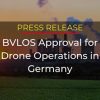By Chris Duncan
It’s summertime, and heatwaves have blanketed sections of the US. This has led to an increased demand for electricity, challenging electric utility companies to keep the power running. To ensure they meet demand and avoid outages, electric utility companies must ensure the power is delivered without interruption. Drone power line inspections can help.
The key to preventing outages is simple: inspect critical electric infrastructure frequently and accurately. Drone power line inspections can provide you with the data necessary to keep power lines operational.
Legacy methods for power line inspection: manual walk-through, piloted drones and helicopters
Power line inspections are commonly done either by in-person walk throughs, or with piloted drones or helicopters equipped with a mounted camera. Performing a powerline inspection with either of these methods is beneficial but limited in frequency, cost and quality.
In the case of the piloted drone, inspections are restricted by pilot availability. Perhaps it involves rearranging onsite staff and taking someone away from their regular duties. This can impact the entire team. The other option is bringing in an outsider which is costly and requires scheduling someone in advance. This limits when the power line inspection can be done and can lead to less frequent inspections. What happens in an emergency?
Using a helicopter with a mounted camera is also impacted by pilot availability. In addition, someone needs to operate the camera. Now, two people need to be pulled away from their jobs onsite or two outsiders need to be brought in. Helicopter inspections can be dangerous as they have to fly close and slowly around power lines. In addition the cost of these inspections is extremely expensive
Data moves slowly from the gathering phase to the analysis phase when using either of the two options. Delays in analyzing the data can result in failures and ultimately downtime.
What an autonomous drone offers power line inspections
A fully autonomous drone does not require rearranging staff or bringing in an outsider for an inspection to occur. In addition, autonomous drones are equipped with software that automatically uploads images and video of power lines to a management system in the cloud. Relevant information is analyzed by advanced AI algorithms that can detect the slightest changes, faults, etc. Notifications of issues are automatically sent to relevant stakeholders so they can quickly address any problems that need attention.

6 Benefits of autonomous drone power line inspection
- Minimize outage time, improve reliability
Infrequent and/or poor-quality inspections lead to small problems becoming major costly challenges. However, with a DIB on site, a utility company can conduct consistent, higher quality inspections, more often resulting in better data to produce actionable insights
Drone power line inspection software, which is part of the DIB, produces valuable data that enables insights. Therefore, faults are quickly detected. Crews can be directed to the exact area requiring repair and have a complete understanding of what needs to be done rather than deploying a team to investigate the problem..
Using a fully automated AI-powered drone for power line inspections leads to minimizing downtime of electric power and delivering reliable service to customers.
- Get the power back up faster when outages do happen
Sometimes mother nature roars, and power lines are impacted. During frantic times immediately following storms, a DIB is invaluable as it can help you restore power quickly.
An on-site DIB can go into the field right after a storm to inspect power lines and right of way. Because the drone is autonomous, there’s no need for an employee to get to the site to fly the drone or even send it on its mission.
An autonomous drone can quickly pinpoint the location of faults and provide maintenance crews with situational awareness. With these insights, repair crews can review the damage before traveling on site, saving time and improving safety.
- Keep employees safe
Even the most standard inspections can be dangerous. However, a fully autonomous power line inspection with an unmanned drone keeps employees out of harm’s way.
Due to live wires, unstable trees, etc., it can be dangerous to send out inspection crews and repair teams after a storm. Instead, let an on-site DIB be the first responder. Armed with drone power line inspection software, a DIB can safely get the data needed to guide repair.

In addition, a drone can scan for hazardous work environments. Site managers can identify safety hazards and ensure employee safety during both routine operations and emergencies.
- Operate remotely
There’s no need to be on site to accurately monitor site operations and track site trends. Missions can be managed from anywhere in the world with a DIB.
In fact, miles and miles of power lines can be operated from one remote location. Continuous visual data streams and AI-powered insights are delivered in real time to one centralized location via inspection software. Site managers gain unprecedented situational awareness.
With this information, relevant stakeholders can communicate with site managers, so maintenance/operations continue to function as expected.
- Reduce operational costs
Unlike other solutions, the fully autonomous DIB is unmanned. There’s no need to pull employees off other projects or increase their responsibilities. They can focus on essential tasks while a more efficient drone inspects power lines.
Drone power line inspection software is highly sophisticated, so even the smallest issues are detected. Utilities can engage in preventive maintenance and boost efficiency. By operating at higher efficiency, operational costs are reduced.
- Eliminate big data challenges
For any utility utilizing piloted drones for power line inspections, there are several big data challenges involved including:
- Finding and reviewing data is time consuming
- All stakeholders don’t have access to the data
- Data analysis is time consuming
Removing these challenges is key for companies to boost efficiency and get the insights needed to improve service reliability. An autonomous drone solution eliminates these challenges by delivering fully end-to-end drone inspections (read more about what that means in our blog here.)





